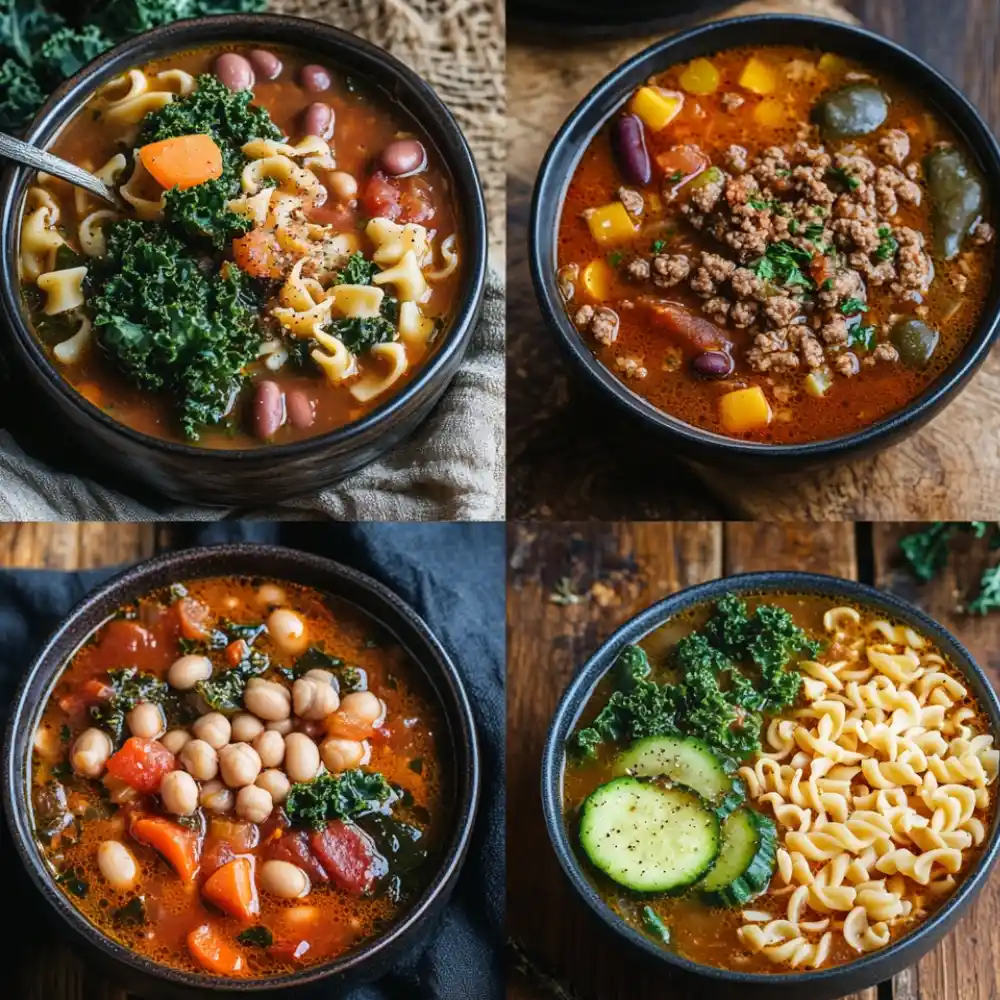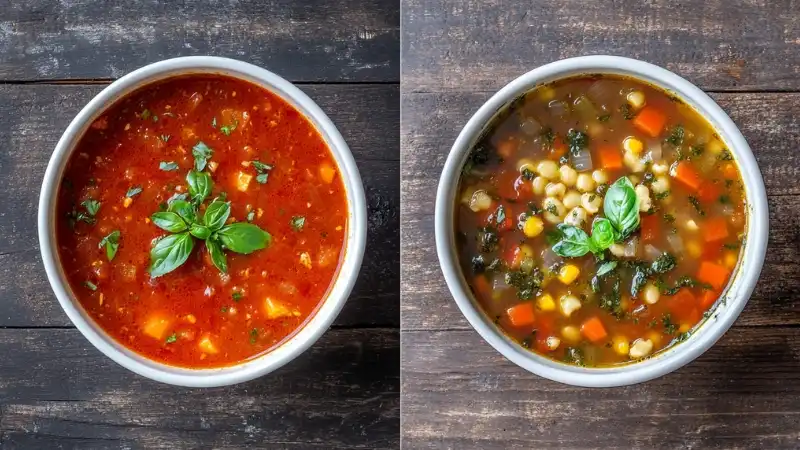Introduction
Few dishes offer the same level of comfort, nutrition, and versatility as Minestrone Soup. This Italian classic is a delicious medley of fresh vegetables, beans, pasta, and rich tomato broth, making it a go-to meal for those seeking both flavor and nourishment. Whether you prefer a traditional Minestrone Soup recipe or enjoy experimenting with variations, there’s no denying its timeless appeal.
In this comprehensive guide, we’ll explore everything you need to know about Minestrone Soup. From its fascinating history to its incredible health benefits, this article will leave you craving a warm bowl of this hearty dish. We’ll also cover expert cooking tips, common mistakes to avoid, and the best ways to serve and store it. By the end, you’ll have all the knowledge you need to make the perfect Minestrone Soup at home!
Now, let’s start by understanding what Minestrone Soup is and why it has become a beloved dish worldwide.
What Is Minestrone Soup?
Origins of Minestrone Soup
Minestrone Soup is a staple of Italian cuisine, dating back to ancient Rome. The term “minestrone” comes from the Italian word minestra, meaning “soup” or “stew.” Initially, it was a humble peasant dish made from seasonal vegetables, legumes, and grains, ingredients readily available to the common folk. Over the centuries, the recipe evolved, incorporating more diverse elements like tomatoes, pasta, and beans, which became key ingredients.
While traditional recipes vary by region, the essence of Minestrone Soup remains unchanged: a thick, flavorful vegetable soup that can be customized to suit different tastes and dietary needs.
What Makes Minestrone Soup Unique?
Unlike other soups, Minestrone isn’t defined by a fixed list of ingredients. It’s one of the most adaptable soups, allowing you to use whatever fresh produce is on hand. Whether you add zucchini, green beans, spinach, or potatoes, every bowl is a nutrient-packed delight.
Another distinguishing feature of Minestrone Soup is its heartiness. Thanks to the combination of vegetables, beans, and pasta, it’s a complete meal on its own, providing a balance of fiber, protein, and essential vitamins.
Common Ingredients in Traditional Minestrone
Though Minestrone Soup recipes vary, some staple ingredients appear in most versions:
- Vegetables – Carrots, celery, onions, zucchini, and tomatoes form the base.
- Legumes – Kidney beans, cannellini beans, or chickpeas add protein and texture.
- Pasta or Rice – Small pasta shapes like ditalini or orzo make it extra filling.
- Broth – Either vegetable or chicken broth enhances the depth of flavor.
- Herbs & Spices – Basil, oregano, thyme, and bay leaves bring an authentic Italian touch.
Some recipes also include Parmesan cheese rinds, pancetta, or ground beef for an added layer of richness. The beauty of Minestrone Soup lies in its flexibility, there’s no “wrong” way to make it!
The History and Evolution of Minestrone Soup
Minestrone in Ancient Rome: The Birth of a Classic Dish
The origins of Minestrone Soup trace back to ancient Rome, where early versions of this dish were common among the lower-class citizens. Roman soldiers and peasants relied on a vegetable-based diet, and their meals often consisted of a thick stew made from whatever grains, legumes, and seasonal produce were available. Back then, tomatoes hadn’t even reached Europe, so the earliest Minestrone was a simple, plant-based concoction.
With the expansion of the Roman Empire, trade routes introduced new ingredients, enriching the flavors and complexity of Italian cuisine. As Romans encountered different cultures, they adopted a wider variety of vegetables, herbs, and spices, laying the foundation for the rich, hearty Minestrone Soup we know today.
How Minestrone Evolved Over Centuries
During the Middle Ages, Italian kitchens transformed Minestrone Soup into a more structured dish. The introduction of tomatoes from the New World in the 16th century was a game-changer, adding the vibrant red base that defines many modern versions. By the Renaissance, pasta and beans had become staple ingredients, making Minestrone a more nutritious and satisfying meal.
Unlike many classic Italian dishes with strict rules, Minestrone Soup continued evolving, adapting to local tastes and seasonal produce. Over time, it spread beyond Italy, becoming a household favorite worldwide. Today, you’ll find countless variations, from the thick, rustic minestrone alla Genovese to lighter, brothy versions popular in southern Italy.
Regional Variations of Minestrone in Italy
Italy’s diverse regions have their own unique take on Minestrone Soup, shaped by local ingredients and traditions:
- Northern Italy: Minestrone alla Milanese features rice instead of pasta and often includes pancetta for a richer taste.
- Central Italy: Tuscan versions highlight white beans and dark leafy greens like kale or spinach.
- Southern Italy: Lighter and brothier, these variations use fresh tomatoes, zucchini, and herbs, reflecting the Mediterranean diet.
No matter the variation, one thing remains constant: Minestrone Soup is a comforting, adaptable dish that celebrates fresh ingredients and wholesome flavors.
Just like Minestrone, many traditional soups from around the world emphasize fresh ingredients and bold flavors. If you’re interested in exploring another comforting dish, check out this Caldo de Pollo Recipe, a delicious Mexican chicken soup with vibrant spices and nourishing broth. Much like its Italian counterpart, it’s a dish that adapts to regional preferences while maintaining its heartwarming essence.
Health Benefits of Minestrone Soup
Nutritional Breakdown of Minestrone Soup
Few soups pack as many nutrients into one bowl as Minestrone Soup. It’s a powerhouse of vitamins, minerals, fiber, and plant-based protein, making it one of the healthiest comfort foods around. A typical serving includes:
- Vitamins A & C: Boosts immunity and promotes healthy skin.
- Iron & Folate: Supports red blood cell production and overall energy levels.
- Fiber: Aids digestion and keeps you full longer.
- Protein: Found in beans, making Minestrone a great plant-based protein source.
Plus, since Minestrone Soup is primarily vegetable-based, it’s naturally low in fat and calories, perfect for those looking to maintain a healthy diet.
Why Minestrone Is a Great Choice for a Balanced Diet
If you’re aiming for a well-rounded diet, Minestrone Soup ticks all the right boxes. It provides a perfect balance of carbohydrates (from pasta or rice), protein (from beans), and healthy fats (from olive oil). Unlike processed meals, it contains no artificial additives, making it a clean and nourishing choice.
What’s more, this soup is highly adaptable. Whether you’re following a vegetarian, vegan, or gluten-free diet, you can tweak the ingredients to suit your needs without compromising on flavor.
How It Supports Gut Health and Immunity
The combination of fiber-rich vegetables and legumes in Minestrone Soup does wonders for digestion. Fiber helps regulate bowel movements, supports gut bacteria, and promotes overall digestive health. Plus, the abundance of antioxidants from tomatoes, garlic, and herbs helps fight inflammation and strengthens your immune system, perfect for flu season!
With all these benefits packed into one bowl, it’s no surprise that Minestrone Soup remains a timeless favorite for health-conscious eaters.
Legumes, like the kidney beans and cannellini beans commonly found in Minestrone, are packed with fiber, plant-based protein, and essential nutrients. Regularly incorporating beans into your diet can help improve digestion, regulate blood sugar, and promote heart health. Learn more about the health benefits of legumes from Harvard T.H. Chan School of Public Health.
How to Make the Best Minestrone Soup at Home

Essential Ingredients for an Authentic Minestrone
Making a delicious pot of Minestrone Soup starts with fresh, high-quality ingredients. While the recipe is flexible, some staples give it that authentic Italian flavor:
- Aromatic base: Onion, garlic, celery, and carrots sautéed in olive oil.
- Vegetables: Zucchini, tomatoes, green beans, and spinach add depth and color.
- Beans: Cannellini, kidney, or garbanzo beans boost the protein content.
- Pasta or rice: Small pasta shapes like ditalini or orzo, or Arborio rice for a unique twist.
- Broth: A good vegetable or chicken broth enhances the overall taste.
- Herbs & seasonings: Basil, oregano, thyme, and bay leaves for that classic Italian touch.
Step-by-Step Cooking Instructions
- Sauté the aromatics: Heat olive oil in a large pot, then cook onions, garlic, carrots, and celery until fragrant.
- Add tomatoes and broth: Stir in diced tomatoes, tomato paste, and broth, bringing everything to a gentle simmer.
- Incorporate vegetables and beans: Toss in zucchini, green beans, and beans, letting them cook until tender.
- Add pasta or rice: Stir in the pasta or rice and cook until it reaches the perfect texture.
- Season and finish: Mix in fresh basil, salt, pepper, and a Parmesan rind for extra depth. Simmer for another 5 minutes, then serve hot!
Best Cooking Tips for Maximum Flavor
- Don’t overcook the pasta: Add pasta towards the end to prevent it from becoming mushy.
- Use a Parmesan rind: Dropping a cheese rind into the broth infuses it with rich, umami flavor.
- Let it rest: Minestrone tastes even better the next day, allowing the flavors to meld beautifully.
- Customize your ingredients: Got leftover veggies? Toss them in! This soup thrives on flexibility.
For a heartier meal, try pairing it with homemade garlic bread or a side of crusty Italian bread.
If you love hearty and comforting soups like Minestrone, you might also enjoy a creamy twist on a classic favorite. This Creamy Chicken Soup Recipe offers a rich, velvety texture with wholesome ingredients that make it perfect for cozy nights. Whether you’re in the mood for a vegetable-packed broth or something creamier, both soups deliver warmth and nourishment in every spoonful.
Minestrone Soup Variations You Should Try

Vegetarian and Vegan Minestrone Options
If you prefer a meatless version, Minestrone Soup is naturally vegetarian. Simply use vegetable broth and skip the Parmesan rind. To make it vegan, replace the cheese with nutritional yeast for a slightly nutty, cheesy flavor. Adding chickpeas or lentils will boost the protein while keeping the soup plant-based.
Gluten-Free and Low-Carb Minestrone Versions
Want to enjoy Minestrone Soup without the carbs? Swap out pasta for:
- Zucchini noodles (zoodles) – A light, fresh alternative.
- Cauliflower rice – Adds texture without extra starch.
- Quinoa – A protein-packed, gluten-free substitute.
For a fully gluten-free minestrone, ensure that your broth and seasonings don’t contain hidden gluten.
Adding Meat and Protein for a Heartier Soup
If you love a meaty twist, consider adding cooked sausage, shredded chicken, or even beef short ribs. Speaking of hearty meals, if you’re looking for a rich, slow-cooked dish
Minestrone’s versatility allows you to tweak it however you like, whether you prefer it classic, plant-based, or packed with protein. No matter the version, this soup remains a wholesome, nourishing delight!
Common Mistakes to Avoid When Making Minestrone Soup
Overcooking the Vegetables
One of the biggest mistakes people make when preparing Minestrone Soup is overcooking the vegetables. Since this soup contains a variety of veggies, each with different cooking times, it’s essential to add them in stages. Soft vegetables like spinach or zucchini should go in toward the end, while heartier ones like carrots and potatoes need more time to cook. This way, every ingredient maintains its texture and doesn’t turn to mush.
Choosing the Wrong Pasta or Beans
Pasta and beans are what make Minestrone Soup hearty, but choosing the wrong types can ruin the dish. Avoid delicate pasta that falls apart easily. Small, sturdy shapes like ditalini, elbow macaroni, or orecchiette work best. Similarly, beans should be fully cooked but not mushy. If using canned beans, rinse them well to remove excess salt, and if using dried beans, soak them beforehand to ensure they cook evenly.
Not Seasoning the Soup Properly
A bland Minestrone Soup is a missed opportunity for deep, rich flavors. Be sure to season in layers. Start with a good base of onions, garlic, and herbs, then add salt and pepper throughout the cooking process. A Parmesan rind, fresh basil, or a splash of balsamic vinegar at the end can take your soup from good to unforgettable!
Serving and Storing Minestrone Soup
Best Side Dishes to Pair with Minestrone
Minestrone Soup is a complete meal on its own, but pairing it with the right sides makes it even more satisfying. A crusty loaf of Italian bread or garlic bread is perfect for soaking up the broth. If you want something lighter, a fresh green salad with a simple vinaigrette adds a crisp contrast to the hearty soup. For a classic Italian touch, serve it with a side of bruschetta or a slice of focaccia.
How to Store and Reheat Minestrone for Maximum Freshness
Got leftovers? Minestrone Soup stores beautifully, making it perfect for meal prep. Let it cool before transferring it to an airtight container and refrigerate for up to 4 days. When reheating, warm it over medium heat on the stove, adding a splash of broth or water if the soup has thickened too much.
Can You Freeze Minestrone Soup? Tips for Long-Term Storage
Absolutely! To freeze Minestrone Soup, let it cool completely and store it in a freezer-safe container for up to 3 months. However, if you’re planning to freeze it, consider leaving out the pasta and adding it fresh when reheating to prevent it from becoming too soft. A quick stir and a sprinkle of fresh herbs will bring it right back to life!
Frequently Asked Questions About Minestrone Soup

Is Minestrone Soup Always Vegetarian?
Not necessarily! While Minestrone Soup is often made with a vegetable-based broth, some traditional Italian versions include pancetta, sausage, or even chicken stock for extra depth of flavor. However, it’s easy to make a delicious vegetarian or vegan Minestrone by using vegetable broth and skipping the meat. If you’re looking for a richer taste, adding a Parmesan rind while simmering can provide a wonderful umami boost. Just remember to remove it before serving!
What Are the Best Pasta Types for Minestrone?
The right pasta makes all the difference in Minestrone Soup. Short, sturdy shapes like ditalini, elbow macaroni, or small shells work best since they hold their shape without becoming mushy. If you prefer a low-carb version, swap traditional pasta for zucchini noodles or cauliflower rice. Pro tip: If you’re making a big batch for leftovers, cook the pasta separately and add it when serving to prevent it from absorbing too much liquid.
How Can I Make Minestrone More Flavorful?
For a bolder, richer Minestrone Soup, start by sautéing onions, garlic, and celery in olive oil before adding broth. Layering flavors with fresh herbs like basil and oregano also enhances the taste. A splash of balsamic vinegar or a squeeze of lemon at the end brightens up the flavors, while a sprinkle of Parmesan cheese gives it a savory kick.
Conclusion and Final Thoughts

Minestrone Soup isn’t just a dish; it’s a comforting, hearty meal packed with fresh ingredients and bold flavors. From its humble origins in ancient Rome to the countless variations enjoyed worldwide today, this Italian classic continues to stand the test of time. Whether you prefer a traditional recipe or like experimenting with new ingredients, there’s no wrong way to enjoy a steaming bowl of Minestrone.
By following the tips and techniques in this guide, you can make a delicious, nutritious soup that’s perfect for any season. Whether you’re cooking for your family, meal prepping for the week, or looking for a cozy meal on a chilly night, Minestrone Soup is a go-to option that never disappoints.
Now that you’re armed with all the knowledge you need, it’s time to grab your favorite vegetables and start cooking. Buon appetito! 🍲

